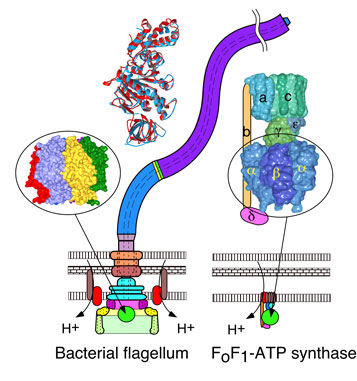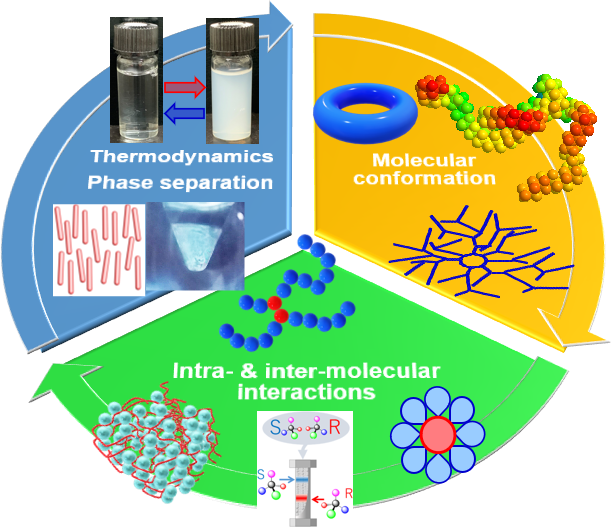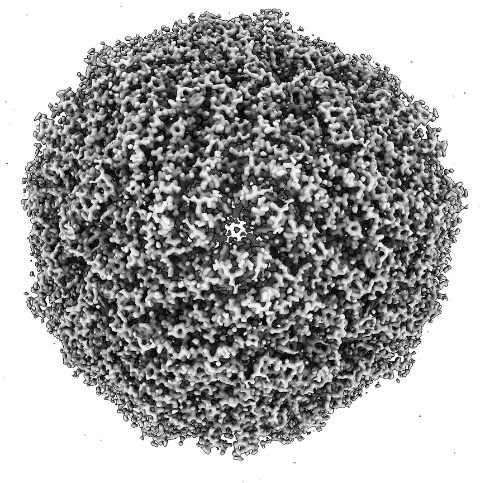Laboratories

The Department of Macromolecular Science comprises three core laboratories and one cooperative laboratory, with each laboratory comprising several research groups. Click on a laboratory name for more details.
Macromolecular Synthesis & Reactions
Polymer Reaction
Chemistry, Macromolecular Precise
Science,
Polymer Synthesis Chemistry,
Polymer
Reaction Chemistry
Kiyotaka ONITSUKA (Professor), Taka-aki OKAMURA (Associate
Professor)
1. Development of new organometallic polymerization
catalysts and their application to synthesis of functional
polymers
2. Functional macromolecular complexes composed of
organometallic units
3. Investigation of the reactivity controlling mechanism in
the active center of metalloenzyme using model complexes
having simple ligands and/or short peptides.
4. Synthesis of non-natural amino acid polymers for higher
order structure formation and expression of novel functions.
5. Sequence and function analyses of proteins and protein
complexes using novel metal complex sequencing reagents.

Macromolecular
Precise Science
Akihito HASHIDZUME (Professor), Masaki NAKAHATA (Assistant Professor)
(1) We synthesize precise macromolecules with well-defined chemical structures because these precise macromolecules are critical for deeper understanding of macromolecularity.
(2) We strive to understand macromolecularity utilizing the precise macromolecules.
(3) We challenge existing boundaries to creation of high-performance macromolecules comparative to biological macromolecules using the precise macromolecules.

Polymer
Synthesis Chemistry
Arihiro KANAZAWA (Associate Professor)
1. Syntheses of well-defined polymers with various
characteristic properties by living cationic polymerization.
2. Syntheses of advanced stimuli-responsive block
copolymers.
3. Investigation of polymerization mechanism and design of
novel living polymerization.

Concept of macromolecular design and living polymerization
for syntheses of well-designed stimuli-responsive polymers
Macromolecular Structure, Properties, and Functions
Polymer Physical Chemistry, Polymeric Materials Design
Polymer
Physical Chemistry
Tadashi INOUE (Professor), Yumi MATSUMIYA (Professor),
Osamu URAKAWA (Associate Professor)
2. Nonlinear rheology and rheo-optics of polymer solids.
3. Molecular motions of hyper-branched polymers.
4. Structure and molecular motions of supramolecules.
5. Hydration and molecular motions of water-soluble polymers
6. Structure and dynamics of polymer composites.
Soft matter stands for soft materials including polymers, liquid crystals, suspensions, and self-assembling molecules which form a large mesoscopic structure much larger than atoms. Soft matters are “soft” and therefore they can easily respond to external fields like strain fields, flow fields, electric fields and so on, and sometimes show drastic structural changes. We have been studying their unique physicochemical properties, particularly nonlinear responses under strong external fields, in addition to their fruitful equilibrium properties and dynamics. Our research is focused on molecular interpretation of rheological phenomena of polymers and micelles as a model system of soft matter.

Polymeric Materials Design
Yoshinori TAKASHIMA (Professor), Kenji YAMAOKA(Assistant Professor)

Macromolecular Assemblies
Macromolecular
Structure,
Supramolecular Science, Polymer Functional
Chemistry
Macromolecular Solutions
Macromolecular
Structure
Katsumi IMADA (Professor),
Tatsuya KAWAGUCHI (Associate Professor (Lecturer)), Norihiro TAKEKAWA (Assistant Professor)
1.Rotational mechanism of the bacterial flagellar motor.
2. Self-assembly mechanism of the bacterial flagellar motor.
3. Structural and functional studies on bacterial protein
secretion systems.
4. Structural and functional studies on environmental
sensing units of bacteria.
5. Study on the structure of polymer complex with small
molecule and its formation mechanism.

The flagellar type III export apparatus and F/V-type ATPases
share a common architecture.
Supramolecular
Science, Polymer Functional Chemistry
Hiroyasu YAMAGUCHI (Professor), Yuichiro KOBAYASHI (Assistant Professor)
In this laboratory, we develop novel materials through hybridization of bio-related macromolecules such as monoclonal antibodies with artificial/synthetic small molecules. We construct functionalized catalytic and energy conversion systems based on specific molecular recognition of biomacromolecules and selective assembly of bio/synthetic molecules.

Macromolecular Solutions
Ken TERAO (Professor), Rintaro TAKAHASHI (Associate Professor)
1 Conformation and molecular recognition ability of polysaccharides and their derivatives
2 Molecular conformation and intermolecular interactions of ring and branched polymers
3 Aggregation and phase separation of branched polymers-poor solvent systems
4 Complex formation of polymers with nanoparticles

Informative Polymer Science (Institute for Protein Research)
CryoEM Structural Biology, Protein Crystallography, Supramolecular Crystallography
CryoEM Structural Biology
Takayuki KATO (Professor), Hiroko TAKAZAKI (Assistant Professor),
Mao OIDE (Assistant Professor)
1. Elucidation of the energy conversion mechanism of rotary molecular motors
2. Development of methods to analyze structural changes of biomolecules in solution
3. Understanding the structure and function of receptor proteins
4. Development of high-resolution structural analysis methods using cryo-electron microscopy
5. Development of sample preparation methods for structural analysis using cryo-electron microscopy

The 1.53Å resolution structure of apoferritin
Protein
Crystallography
Genji KURISU (Professor), Akihiro KAWAMOTO (Associate Professor)
2. Crystal structure analyses of dynein motor
3. High resolution structural analysis of rat liver vault
Three-dimensional protein structure brings us a deeper insight into the biological function. X-ray crystallography is the best method to determine atomic coordinates of protein molecules. The main aim of our group is the X-ray structure determination of the biological macromolecular assemblies including membrane protein complexes, in order to elucidate the molecular mechanism of the highly organized biological processes at atomic level.

Crystal Structure of the dynein motor domain
Supramolecular Crystallography
Atsushi NAKAGAWA (Professor),
Eiki YAMASHITA (Associate Professor),
Makoto MATSUDA (Assistant Professor)
2. Developing a new crystallographic techniques for structure determination of biological macromolecular assemblies.
3. Structural studies of biological macromolecules and biological macromolecular assemblies.
4. Structural studies on proteins working in brain and nervous system.
Macromolecule assemblies, consisting of proteins, nucleic acids, and other substances, play key roles in all living system. Our laboratory works on structure determination of biological macromolecular assemblies using X-ray diffraction technique. Development of tools for X-ray crystallography of biological macromolecular assemblies, including the synchrotron radiation beamline at SPring-8, is also one of our main works.

Department for the Administration of Safety and Hygiene
Chemistry
for Environment and Safety
Hitoshi YAMAMOTO (Professor), Masaomi TAKAHASHI (Associate Professor)
2. Development of the photo-switching functional molecules.
3. Development of detection methods for environmental chemicals.
4. Construction of education system for realization of safety concious culture in the university.
5. Research and analyses of university accidents in the world.
This laboratory belongs to the department for the administration of safety and hygiene, whose mission is managing safety and hygiene of all people constituting the university. The research in this laboratory aims to contribute to the safety of wide area in science and technology. At present, our research projects focus on development of new functional molecules such as low barrier ion conductive polymers for the safety of Li ion batteries, photo-switchable hydrogen bonds for environmental chemistry, etc. In addition, our laboratory proposes safe methods and techniques for conducting research and experiments through investigation and analyses of university accidents in the world.
